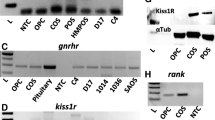Abstract
The present study examines the effect of the endogenous neuroendoccrine factor, corticotropin-releasing factor (CRF), alone or in combination with 5-fluorouracil (5-FU), on 4T1 mammary tumor cells in vitro and in vivo. CRF has been detected in breast cancer tissues; however, the biological effects reported in the literature are sparse and variable. We found that exogenously administered CRF significantly reduced tumor growth without influencing angiogenesis or cell death. Furthermore, CRF reduced tumor interstitial fluid pressure (Pif) and potentiated the effect of 5-FU. These results show that CRF has antitumor effect on mammary carcinoma in mice.



Similar content being viewed by others
References
Androulidaki A, Dermitzaki E, Venihaki M, Karagianni E, Rassouli O, Andreakou E, et al. Corticotropin releasing factor promotes breast cancer cell motility and invasiveness. Mol Cancer. 2009;8:30.
Arranz A, Venihaki M, Mol B, Androulidaki A, Dermitzaki E, Rassouli O, et al. The impact of stress on tumor growth: peripheral CRF mediates tumor-promoting effects of stress. Mol Cancer. 2010;9:261.
Beaumont A, Marmarou A. The effect of human corticotrophin releasing factor on the formation of post-traumatic cerebral edema. Acta Neurochir Supplement. 1998;71:149–52.
Chauhan VP, Stylianopoulos T, Boucher Y, Jain RK. Delivery of molecular and nanoscale medicine to tumors: transport barriers and strategies. Ann Re Chem Biomol Eng. 2011;2:281–98.
Ciocca DR, Puy LA, Fasoli LC, Tello O, Aznar JC, Gago FE, et al. Corticotropin-releasing hormone, luteinizing hormone-releasing hormone, growth hormone-releasing hormone, and somatostatin-like immunoreactivities in biopsies from breast cancer patients. Breast Cancer Res Treat. 1990;15:175–84.
Friman T, Gustafsson R, Stuhr LB, Chidiac J, Heldin NE, Reed RK, et al. Increased fibrosis and interstitial fluid pressure in two different types of syngeneic murine carcinoma grown in integrin beta3-subunit deficient mice. PloS One. 2012;7:e34082.
Gjerde EA, Woie K, Wei ET, Reed RK. Corticotropin-releasing hormone inhibits lowering of interstitial pressure in rat trachea after neurogenic inflammation. Eur J Pharmacol. 1998;352:99–102.
Graziani G, Tentori L, Muzi A, Vergati M, Tringali G, Pozzoli G, et al. Evidence that corticotropin-releasing hormone inhibits cell growth of human breast cancer cells via the activation of CRH-R1 receptor subtype. Mol Cell Endocrinol. 2007;264:44–9.
Heldin CH, Rubin K, Pietras K, Ostman A. High interstitial fluid pressure—an obstacle in cancer therapy. Nat Rev Cancer. 2004;4:806–13.
Hofmann M, McCormack E, Mujic M, Rossberg M, Bernd A, Bereiter-Hahn J, et al. Increased plasma colloid osmotic pressure facilitates the uptake of therapeutic macromolecules in a xenograft tumor model. Neoplasia. 2009;11:812–22.
Jain RK. Transport of molecules in the tumor interstitium: a review. Cancer Res. 1987;47:3039–51.
Jain RK. Vascular and interstitial barriers to delivery of therapeutic agents in tumors. Cancer Metastasis Rev. 1990;9:253–66.
Kaprara A, Pazaitou-Panayiotou K, Chemonidou MC, Constantinidis TC, Lambropoulou M, Koffa M, et al. Distinct distribution of corticotropin releasing factor receptors in human breast cancer. Neuropeptides. 2010;44:355–61.
Kim BJ, Jones HP. Implications of corticotropin releasing factor in targeted anticancer therapy. J Pharm Pract. 2010;23:86–90.
Klosowska-Wardega A, Hasumi Y, Burmakin M, Ahgren A, Stuhr L, Moen I, et al. Combined anti-angiogenic therapy targeting PDGF and VEGF receptors lowers the interstitial fluid pressure in a murine experimental carcinoma. PloS One. 2009;4:e8149.
Oldberg A, Kalamajski S, Salnikov AV, Stuhr L, Morgelin M, Reed RK, et al. Collagen-binding proteoglycan fibromodulin can determine stroma matrix structure and fluid balance in experimental carcinoma. Proc Natl Acad Sci U S A. 2007;104:13966–71.
Owens MJ, Nemeroff CB. Physiology and pharmacology of corticotropin-releasing factor. Pharmacol Rev. 1991;43:425–73.
Pietras K, Rubin K, Sjoblom T, Buchdunger E, Sjoquist M, Heldin CH, et al. Inhibition of PDGF receptor signaling in tumor stroma enhances antitumor effect of chemotherapy. Cancer Res. 2002;62:5476–84.
Radulovic M, Hippel C, Spiess J. Corticotropin-releasing factor (CRF) rapidly suppresses apoptosis by acting upstream of the activation of caspases. J Neurochem. 2003;84:1074–85.
Reed RK, Rubin K. Transcapillary exchange: role and importance of the interstitial fluid pressure and the extracellular matrix. Cardiovasc Res. 2010;87:211–7.
Rodt SA, Reed RK, Ljungstrom M, Gustafsson TO, Rubin K. The anti-inflammatory agent alpha-trinositol exerts its edema-preventing effects through modulation of beta 1 integrin function. Circ Res. 1994;75:942–8.
Salnikov AV, Iversen VV, Koisti M, Sundberg C, Johansson L, Stuhr LB, et al. Lowering of tumor interstitial fluid pressure specifically augments efficacy of chemotherapy. FASEB J: Off Publication Fed Am Soc Exp Biol. 2003;17:1756–8.
Salnikov AV, Roswall P, Sundberg C, Gardner H, Heldin NE, Rubin K. Inhibition of TGF-beta modulates macrophages and vessel maturation in parallel to a lowering of interstitial fluid pressure in experimental carcinoma. Lab Invest. 2005;85:512–21.
Slominski A, Zbytek B, Nikolakis G, Manna PR, Skobowiat C, Zmijewski M, et al. Steroidogenesis in the skin: implications for local immune functions. J Steroid Biochem Mol Biol. 2013. doi:10.1016/j.jsbmb.2013.02.006.
Stuhr LE, Moen I, Nedrebo T, Salnikov AV, Wiig H, Rubin K, et al. Peritumoral TNFalpha administration influences tumour stroma structure and physiology independently of growth in DMBA-induced mammary tumours. Scand J Clin Lab Invest. 2008;68:602–11.
Tjuvajev J, Kolesnikov Y, Joshi R, Sherinski J, Koutcher L, Zhou Y, et al. Anti-neoplastic properties of human corticotropin releasing factor: involvement of the nitric oxide pathway. In vivo. 1998;12:1–10.
Wei ET, Gao GC. Corticotropin-releasing factor: an inhibitor of vascular leakage in rat skeletal muscle and brain cortex after injury. Regul Pept. 1991;33:93–104.
Wei ET, Thomas HA. Anti-inflammatory peptide agonists. Annu Rev Pharmacol Toxicol. 1993;33:91–108.
Wei ET, Thomas HA, Christian HC, Buckingham JC, Kishimoto T. d-Amino acid-substituted analogs of corticotropin-releasing hormone (CRH) and urocortin with selective agonist activity at CRH1 and CRH2beta receptors. Peptides. 1998;19:1183–90.
Acknowledgments
This work was supported by grant from The Research Council of Norway.
Conflicts of interest
E.T. Wei is part holder in two US patents (06803359 and 063319900) on the use of CRF analogs for the inhibition of abnormal cell growth.
Author information
Authors and Affiliations
Corresponding author
Rights and permissions
About this article
Cite this article
Stuhr, L.E.B., Wei, E.T. & Reed, R.K. Corticotropin-releasing factor reduces tumor volume, halts further growth, and enhances the effect of chemotherapy in 4T1 mammary carcinoma in mice. Tumor Biol. 35, 1365–1370 (2014). https://doi.org/10.1007/s13277-013-1186-0
Received:
Accepted:
Published:
Issue Date:
DOI: https://doi.org/10.1007/s13277-013-1186-0




